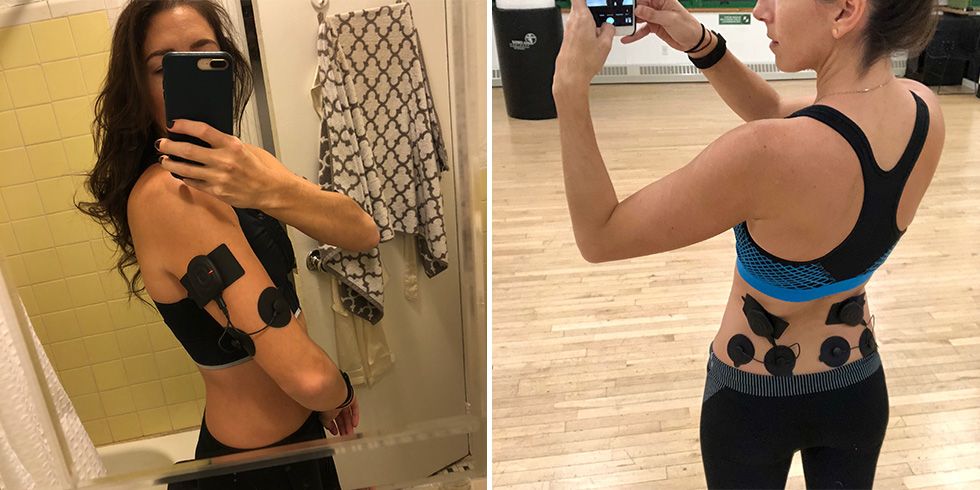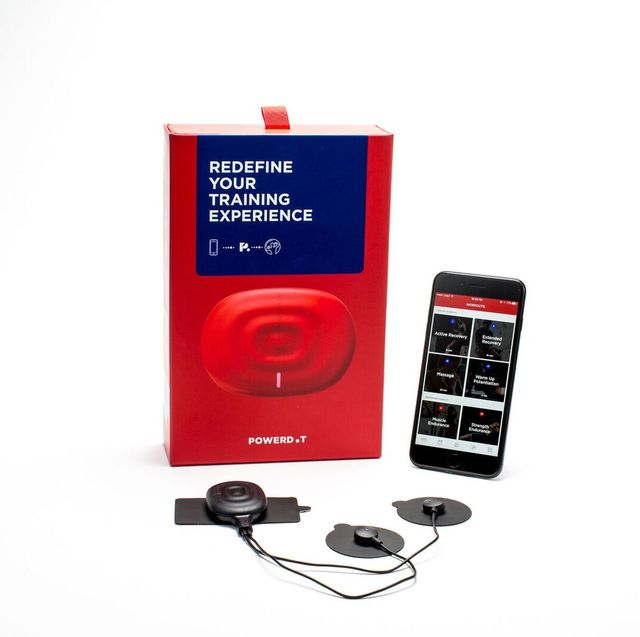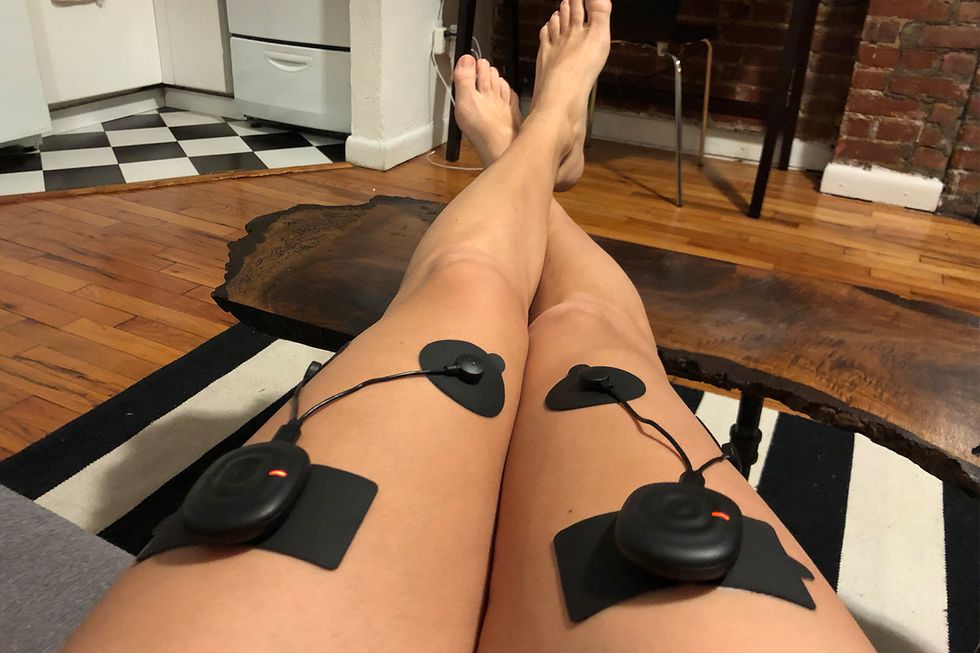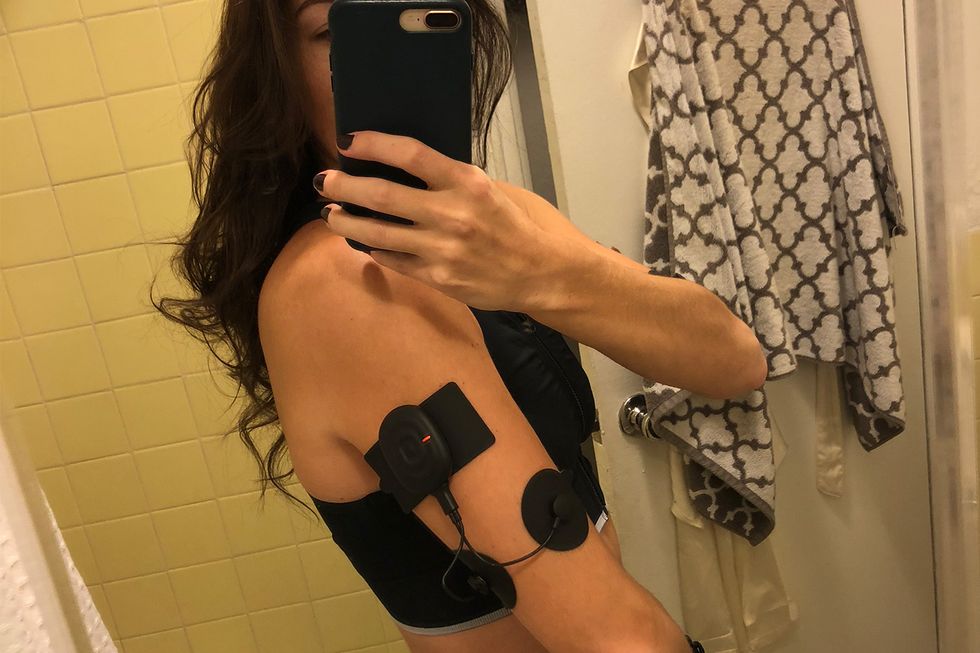Here’s a fitness confession: I hate recovery work. I know that stretching, foam rolling, resting, and so forth are all crucial to working out—it’s what allows your body to repair all the tissues you stress during exercise—but it’s rare that I force myself to tack on that extra time after a workout.
That’s where electric muscle stimulation therapy comes in. EMST isn’t new; physical therapists and rehabs have been using it for years. “EMST is an electrical current that, through a machine, is designed to target motor nerves,” explains Dan Giordano, a physical therapist and certified strength and conditioning specialist. “Motor nerves are the nerves that activate muscle, so what EMST does is activate the muscle to contract.”
How it works is PTs will place little electrode sticky pads on various parts of your body, which are then connected to wires attached to the machine. You can use this treatment to increase muscle strength or to help with muscle recovery, depending on the type and amount of stimulation you apply.
The fact that you can now do this at home, though, is relatively new. One such product on the market: PowerDot, a portable EMST device that comes complete with a Bluetooth-controlled pod, electrode pads, cables, and a neat little carry case. Considering the touted benefits of EMST, I thought I'd give this at-home product a try, to see if it could enhance my workouts and recovery. Here's what my experience was like:
'I Felt A Nice, Warm Stimulation'
The first time I tried it, I used the “active recovery” setting on my lower back after 60 minutes on the elliptical. I had some trouble getting the electrodes to stick (and they made me look like I should be under a doctor’s care, not traipsing through my gym), but once I did, I set the stimulation to increase automatically and I felt a nice warm sensation there for the next 21 minutes.
The second day, I slapped on the electrodes after a fast three-mile run, and used the “extended recovery” setting on my quads for 33 minutes. While I watched TV, my legs up on my coffee table, I could feel pinpricks of stimulation right under the pads. It felt pretty nice.
And on the third day, I used the “strength” setting on my triceps for 26 minutes after a power vinyasa class full of chaturangas. This was the first “performance” setting I used versus a “recovery” setting, and I could feel the difference—the intensity went way up (although it still felt good), until I could actually see the device cause my muscle to contract. Remember: the purpose of the strength setting is not to recover, but to build more muscle.
'I did feel slightly less sore'
I kept this routine up for a week, then checked in with Giordano to find out what exactly was happening to my body. Giordano actually said I could use the EMST for active recovery every day. “Basically, this is going to speed up your recovery,” he explained. “What it does is increase the blood flow to your muscles. More blood flow means more red blood cells, which means more oxygen. And more oxygen to the muscles speeds up the healing process and flushes the waste from your muscles more quickly.”
I did notice that I felt slightly less sore in the areas where I place the electrodes after my workouts this week. Whether it was the placebo effect or actually a result of the EMST, I couldn’t tell you, but if all I need to do to ward off exercise aches is spend 20 minutes a day with those electrodes on, that doesn’t sound too bad.
'But don't get too pulse-happy'
The issue with EMST comes when people get too pulse-happy with the strength-building function. “The problem is that if you recruit too many motor neurons too often, you’re going to stress the tissue too much—your body won’t have time to heal itself,” Giordano says.
That's why the PowerDot recommends using the "performance" setting no more than three to five times a week.
Like most workout aids, then, EMST isn’t a quick fix. Just because it works doesn’t mean you should go HAM on it—you can use it for an edge, but you can’t use it every day.
The bottom line
I honestly couldn’t tell if I felt any stronger after using the PowerDot for just a week, but it’s definitely something I would try again if I were, say, training for a race, to see if it helped my recovery time and performance.
If you want to use the PowerDot for strength-building purposes, Giordano recommends using it in eight-week cycles: Train with it for four to six weeks, allowing your body to get used to it, then give yourself a few weeks off. “Eventually, like any time you do the same workout for too long, you’re going to plateau,” he says.
That recovery setting, though? Feel free to go wild with that—even if it’s just to feel like you're getting a massage.



















